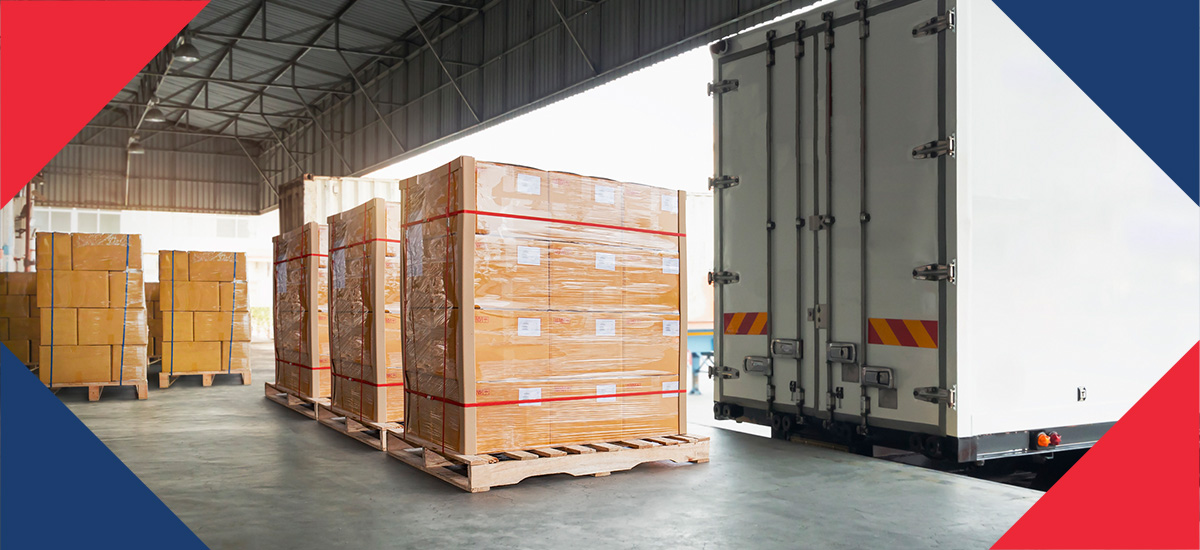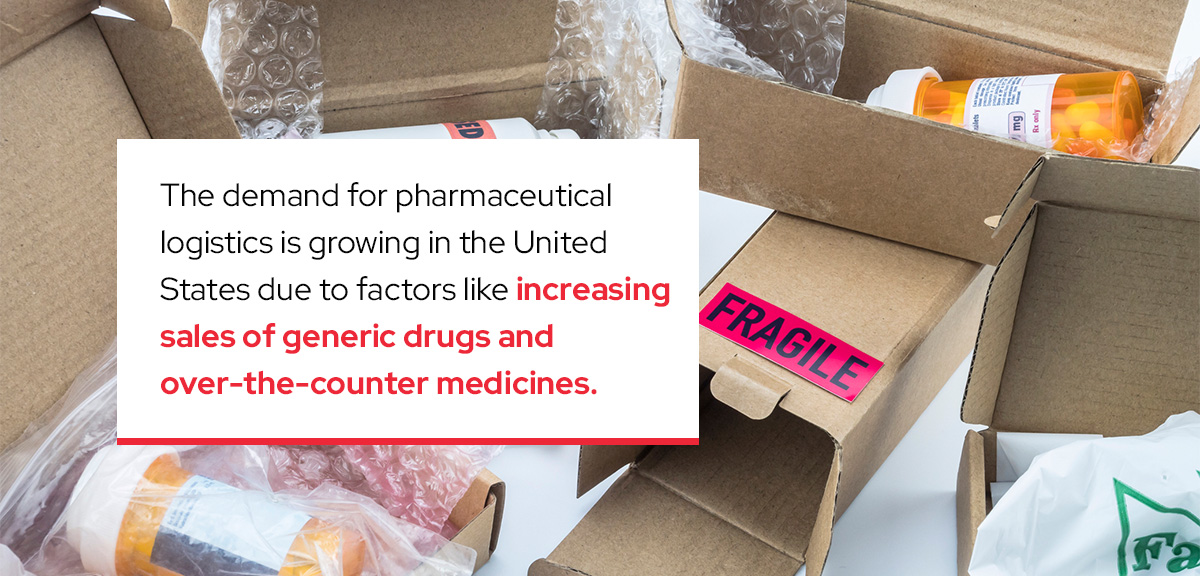
Pharmaceutical shipping regulations ensure that pharmaceuticals remain safe and effective throughout the shipping process. However, with multiple regulatory bodies and varying requirements across regions, staying compliant can be challenging.
Use our guide to augment your pharma shipping operations, ensure compliance and learn how to find the right partner for your logistics needs.
Important Factors to Be Aware of When Shipping Pharmaceuticals
Several factors ensure pharmaceutical shipments remain compliant with regulations, including:
- Temperature control: Many pharmaceuticals — especially biologics and vaccines — require strict temperature control. Failure to maintain these conditions can lead to product degradation that impacts patients. Many businesses rely on special vehicles, such as refrigerated trucks with improved gaskets and seals, to maintain temperature control during transport. Other solutions include insulated packaging with gel packs.
- Packaging standards: Medications must be packed securely to prevent damage and contamination. Packaging should also help ensure temperature stability during transit. Ideally, boxes contain individual compartments to prevent shifting and chemical reactions. They should also be tamperproof for improved safety.
- Documentation: Proper paperwork, including shipping manifests and permits, is required for legal compliance and to ensure safe deliveries. Detailed documentation should include product descriptions, temperature logs and reports of any incidents that occur during transport.
- Insurance coverage: Insurance helps mitigate financial risks associated with shipping pharmaceuticals in case of loss or damage.
- Facility requirements: Storage facilities should allow for proper cleaning and airflow. Separate quarantine areas maintain high hygiene standards and prevent contamination.
- Security measures: Security protocols, such as surveillance cameras, access control systems and automatic locking doors, can help restrict access to pharmaceutical storage areas.
Pharmaceutical Shipping Regulations
The demand for pharmaceutical logistics is growing in the United States due to factors like increasing sales of generic drugs and over-the-counter medicines. Additionally, the rise of telehealth and online pharmacies has increased scrutiny of shipping protocols.
Unforeseen snags and evolving regulations make pharmaceutical shipping a challenging endeavor. Keeping up with these regulations and planning carefully can help mitigate issues in the cold supply chain.
Current Pharma and Medicine Shipping Regulations
Several regulatory bodies oversee pharmaceutical shipping practices to ensure products are transported safely and effectively. Here are some of the organizations involved:
- Food and Drug Administration (FDA): The FDA regulates the shipment of pharmaceuticals in the U.S., ensuring that drugs are safe, effective and manufactured according to established standards. They enforce Good Distribution Practices and Title 21 of the Code of Federal Regulations, which pertain to the storage, handling and shipping of pharma products.
- World Health Organization (WHO): WHO provides international guidelines and best practices for pharmaceutical shipping and distribution. They prioritize ensuring access to quality medicines globally.
- Centers for Disease Control and Prevention (CDC): In the U.S., the CDC regulates the shipping of certain pharmaceuticals, especially vaccines and biologics, to ensure they’re transported under appropriate conditions.
- International Air Transport Association (IATA): While not a regulatory body, IATA is a trade association that provides guidelines for the air transport of pharmaceuticals. For example, they enforce temperature control and packaging standards to ensure compliance with international shipping regulations.
Generally, pharmaceutical shipping regulations encompass everything from refrigerated vehicle designs to temperature control measures and proper product documentation.
Consequences of Noncompliance
Noncompliance with pharmaceutical shipping regulations can have serious consequences, such as:
- Legal penalties: Businesses that violate shipping regulations may face significant fines. Noncompliance can also lead to lawsuits from affected parties.
- Product recalls: Companies may be required to initiate product recalls if pharmaceuticals are found to be noncompliant. Recalls can be costly and logistically challenging.
- Suspension or revocation: Regulatory authorities may suspend or revoke licenses necessary for operating in the pharmaceutical industry, effectively halting business operations. Businesses may also be subject to increased scrutiny and more frequent inspections in the future.
- Disruptions in the supply chain: Noncompliance can disrupt the supply chain, leading to shipping delays. This may affect relationships with end users.
- Reputational damage: Businesses that fail to comply with regulations may find it difficult to regain the trust of health care providers and end users. They may not be able to compete with compliant organizations that maintain high standards.
- Public health impact: When noncompliance leads to the widespread distribution of ineffective or unsafe products, it can result in serious public health complications.
How to Ship Medicine According to Regulations
Here’s a step-by-step guide on how to ship medicine and other pharmaceuticals in compliance with regulations:
- Assess the risks: Discuss shipping routes with your logistics provider to evaluate potential delays or environmental factors that may affect product integrity. Develop contingency plans for unexpected situations.
- Know the specifics: Be aware of specific requirements related to the type of pharmaceuticals being shipped, such as biologics, controlled substances or vaccines.
- Use temperature-controlled packaging: Identify the required temperature range for your products. For example, vaccines must be kept between 36 and 46 degrees Fahrenheit. Use insulated containers or specialized packaging solutions that maintain the required temperature range throughout transit.
- Add PCMs: Phase-change materials (PCMs) absorb or release heat to keep products within the desired temperature range. For example, gel packs absorb and store ambient heat. These packs “remove” heat from the shipping box as they change from solid to liquid. Gel packs for shipping pharmaceuticals are excellent in hybrid and passive temperature-controlled packaging. They are a cost-effective option that helps maintain the required temperatures of shipments.
- Employ monitoring devices: Use data loggers or Internet of Things-enabled monitoring systems to track real-time temperatures throughout shipping.
- Train staff: Educate staff involved in packaging, handling and transporting pharmaceuticals on the importance of temperature control and compliance with regulations. Develop and implement standard operating procedures for handling temperature-sensitive products, including protocols for emergency situations.
- Select reliable carriers: Partner with experienced logistics providers that specialize in pharmaceutical shipping and have established protocols for maintaining temperature control.
- Document: Keep detailed records of temperature monitoring data, shipping conditions and any incidents related to temperature excursions. Regularly review these documents to ensure compliance with regulatory requirements and internal policies.
Ship Pharma Products With Gel Packs From Pelton Shepherd
A key aspect of adhering to pharmaceutical shipping regulations involves maintaining the appropriate temperatures. Insulated shipping boxes and refrigerated trucks can help ensure your business complies with regulations, and gel packs can further improve your processes — especially in the case of last-mile deliveries.
Gel packs help stabilize temperatures within insulated packaging, thereby ensuring compliance with regulations. They are easier to use and safer to handle than dry ice, and they are an excellent choice for businesses that prioritize sustainability.
Pelton Shepherd Industries can help you achieve operational efficiency and compliance with our selection of gel packs. Our products are available in various sizes, shapes and eutectic points to meet temperature control needs. To further simplify your cold chain logistics, we can store your gel packs at one of our facilities or partner facilities. We’ll ensure your orders are ready on time, and you can save on the costs associated with keeping cold packs on-site.
Get in touch for tailored logistics solutions.



